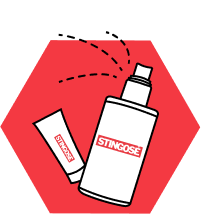As summer rolls in, many people are spending more time at home and in their backyards — unfortunately, when the warm weather arrives, so do the mosquitoes. So, if you don’t want that annoying buzzing in the middle of the night it’s best to try to prevent mosquitoes getting into your home in the first place!
From mosquito repellent plants to treatments like Stingose products, here are seven simple tips on how to control mosquitoes in the home — so you can focus on keeping the fun in and the mozzies out.
Why Do I Have Mosquitoes in My House?
If you’re wondering why you have mosquitoes in your house, mosquito eggs are likely the cause. Mosquito eggs can hatch in just a few days, with the larvae developing into adulthood in the space of about a week. From mosquito repelling plants to bug zappers and door screens, this article’s simple steps will help you get rid of mosquitoes in the home.
Mosquitoes lay eggs in standing (still) water. While they only need a small amount of water to lay their eggs in, it must be stagnant for at least six days in order for the larvae to fully develop. Have a good look around your house, garden, patio, yard or balcony for any sources of still water – by removing them you can start to limit their breeding areas and help keep mosquitoes away from the backyard, patio and around your home.
Watch out for plants such as bromeliads which catch and hold water. Regularly rinsing the plants out with a high-pressure hose can remove mosquito larvae before they can fully develop. You can contact your local council or health authority for more tips and information on mosquitoes in your area and how best to control them. Interestingly, in Queensland you could be fined by your local council if you have a mosquito breeding ground present around your home.
How to Control Mosquitoes Breeding in Water Features:
- Emptying or covering any items that hold water such as buckets, wheelbarrows, water tanks or other containers. Wire mosquito net can be used as a replacement lid for containers holding water, provided the holes are small enough to block adult mosquitoes (generally, no bigger than 1 mm).
- Make sure that any container that can’t be covered (such as bird baths or pet drinking bowls) are emptied and thoroughly cleaned at least once a week.
- Put sand around the base of plant pots to help absorb water that collects in the dish. Watch out for plants such as bromeliads which catch and hold water. Regularly rinsing the plants out with a high-pressure hose can remove mosquito larvae before they can fully develop.
Mosquitoes are mostly found in warm, humid areas. Outside, this means areas such as under carports and patio furniture or amongst overgrown vegetation. Make sure your lawns and gardens are kept tidy in order to minimise these areas. Fish ponds and swimming pools should be well-maintained with minimal vegetation around their edges. You can also grow mosquito repellent plants to repel mosquitoes in the garden.
While ‘knock-down’ fly sprays can be used to kill mosquitoes you can see, there are also a range of products which act as more general mosquito repellent to help keep mozzies away.
Insect sprays and mosquito repellent can be used to target the dark, humid areas around your home where mosquitoes like to hide, such as under the sink, in the shower or behind furniture. When using an outdoor mosquito repellent, focus on areas such as under bushes or patio furniture, making sure to avoid any fish ponds and other sources of water which may be consumed. Remember to always carefully follow the instructions when using insecticides.
If you are spending a long time outside, mosquito coils can help repel mosquitos. As they burn, they release smoke which interferes with the mosquito’s senses. Make sure to place the coils upwind of where you are and to never leave them burning unattended.
Alternatively, if you are staying close to your house and have access to a power point, try a plug-in mosquito zapper. For the most effective relief from mosquitoes, you may need to use insect spray as well — the key is finding which products work best for you and your lifestyle.
One of the simplest steps to take when trying to prevent mosquito bites is to use fly screens. Ideally, there should be flyscreens on every door, window, vent and chimney to help control the mosquitoes entering your home.
As summer arrives, it’s a good idea to take the time to check your flyscreens for any holes or tears — and try not to ‘invite’ the mozzies in by leaving any doors or windows open if they do not don’t have flyscreens on.
Remember to be prepared and don’t forget the Stingose. Even if you’ve taken steps to get rid of mosquitoes, there are always occasions when a mozzie has made its way in and is making a pest of itself, probably leaving any itchy bump or two behind! Apply Stingose immediately after a sting or bite to quickly minimise the pain, itch and inflammation.
Doors are one of the most common ways that mosquitoes get into homes. They can squeeze through tiny cracks and crevices, and will begin reproducing once indoors. That’s why it’s so important to keep doors closed: especially during the summer months when mosquitoes are most active. It’s also important to remind children to close doors, as they may not be aware of the dangers of letting mosquitoes in. If you have pets, you may also want to consider getting a cat or dog flap as this will allow them to go in and out of the house without letting mosquitoes in.
One of the best ways to avoid mosquitoes is to keep outdoor areas clean and free of junk. Items like old tires, small containers or piles of leaves can collect water, providing a perfect place for mosquitoes to lay their eggs. Mosquitoes are attracted to dark, shady areas; if your property is cluttered with debris, it’s more likely that mosquitoes will find a place to hide and breed.
There are many different types of mosquito traps available on the market, but they all work by essentially doing the same thing: attracting mosquitoes and then trapping them so they can’t escape. While mosquito traps won’t completely get rid of mosquitoes in an area, they can significantly reduce their numbers. Traps can be placed either indoors or outdoors, depending on your needs.
Some traps use light or sound to attract mosquitoes, while others use a combination of heat and carbon dioxide. Once the mosquitoes are drawn into the trap, they become tangled in a net or stick to a glue board, where they eventually die. Liquid traps use a sweet-smelling attractant to lure mosquitoes into a container of water, where they will drown.
Alternatively, electric mosquito traps work by emitting a high-pitched sound that is only audible to mosquitoes. The sound waves vibrations will kill the mosquito upon contact. These types of traps are often used in large outdoor areas, such as parks or picnic areas.
Finally, bait boxes lure mosquitoes into a box with an insecticide-laced strip. The mosquitoes will then die after coming into contact with the strip. Bait boxes are often used in yards or gardens where there is dense vegetation.
What If I Got Bitten?
If you’re unfortunate enough to get bitten by a mosquito, there are a few things you can do to relieve the itch and pain. First, wash the area with soap and water. This will help to remove any germs or toxins that the mosquito may have injected. Next, apply a cold compress to the bite. This will help to reduce swelling and pain. Finally, if you have Stingose gel or spray handy, apply it to the bite. Stingose contains ingredients that help to soothe the skin and provide relief from itching. If you’ve been unlucky enough to get bitten by a mosquito, follow these simple steps and reach for Stingose products to help ease your symptoms.




